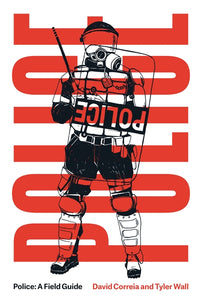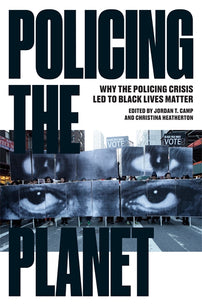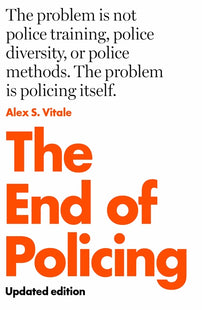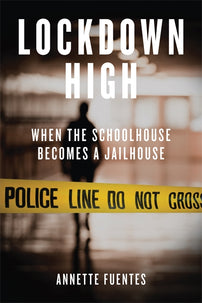From New York to Salt Lake City, There’s No Such Thing as a Nice Prison
A Discussion between Brinley Froelich, Zhandarka Kurti, and Jarrod Shanahan on how criminal justice initiatives are furnishing the ideology behind jail and prison expansion in the America, and anti-prison organising across the country.

We linked up at the Fifth Annual Transformative Justice and Abolition conference at Salt Lake City Community College for a discussion of how criminal justice reforms in Utah and New York are giving way to the construction of new carceral facilities and new ideologies supporting mass incarceration.
ZK: In our New York City research, Jarrod and I have been interested in the current terrain that has made possible both discussions about decarceration and abolition, and reforms that seem to be just tinkering with the system without getting at the root causes of incarceration. What’s the situation in Utah?
BF: Utah is a red state, so talk of reform is usually from a conservative or libertarian perspective. At least as far as legislation goes, it’s always being passed by conservative representatives. But they are talking about reform and saying it’s something they support. I think it’s different from movements in New York and other blue states where it’s liberals versus more radical abolitionists. There’s sort of a liberal left here but it’s pretty right-leaning. Then there are fringe abolitionists that are trying to push back.
We passed the Justice Reinvestment initiative in 2015. That was supposed to reduce a lot of charges from felonies to misdemeanors to lower the population of the prisons. Instead, we’ve seen a growth in the prison population, mostly due to an increase in the length of stay of the prisoners. Seventy percent of people released are reconvicted. It’s this mess of people not being able to find jobs and housing and often getting caught up in aggressive street-level policing strategies like Operation Rio Grande, caught up in this cycle, going in and coming out. It’s hard to say what the reform efforts are because it’s basically just talk; what’s actually happening is not a reform at all, it’s just growing the prison population.
JS: Speaking of Operation Rio Grande, the ACLU Utah report you showed us, entitled “Endgame for Operation Rio Grande” celebrates the move away from an aggressive arrest strategy and toward what they call “service-focused policing,” which pairs a social worker and a cop together…
BF: They tried that before with Operation Diversion and it totally failed. It was the same thing; they said they were trying to “avoid the criminal justice system” by sending people to drug courts or pointing them toward services. But what it did was get people in contact with the criminal justice system. Only 2% of the people who went through drug court went to a rehab program that they graduated from. Before Operation Rio Grande started a handful of us said you should stop Operation Diversion because it’s not working. But real estate interests trumped moral interests. The homeless shelter was on prime real estate, where developers were trying to build luxury town homes. Instead of trying something else, they amped up Operation Diversion into Operation Rio Grande, which dispersed the population and made it more difficult for social workers to do their jobs.
[book-strip index="1" style="display"]JS: Zhana and I have run into some similar things in New York City, specifically this idea that cops can somehow spearhead the alternative to feeding somebody into the criminal justice system.
ZK: Yes and this ideology is becoming more popular especially in NYC as city officials are gearing up to replace Rikers Island with a series of brand new neighborhood-based jails In a previous paper we wrote on this topic, we argued that the expansion of alternatives to incarceration programs in the wake of this downsizing and relocation is not going to replace mass incarceration by a long shot. Instead the burden will be shifted to non-profit organizations and other institutions of the carceral state which means that communities of color will still be entangled in the carceral net. So, what we are witnessing instead is the rebranding of mass incarceration. In many ways New York is an interesting case because it has a long history of “diversion” programs. Yet in recent years due to the push created by the crisis of mass incarceration such programs have been expanded and incorporated into “needs based” approach into the criminal justice apparatus. So now police and courts can help people get “the help they need.” If you go to Times Square, for instance, you see people of color cleaning the area dressed in Times Square Alliance jackets. They are largely homeless and substance-dependent folks who were arrested on petty offenses and taken to Midtown Community Court, which was founded in 1994 as part of “quality of life,” “Broken Windows” policing. Reformers said: “We don’t want to overwhelm the criminal court, let’s make a separate community court where we can actually help people and connect them to services.” While this seems well-intentioned it’s not. First the Midtown Court was an integral aspect of the criminalization of sex workers and homeless folks who were getting in the way of real estate and businesses from gentrifying Times Square. Secondly, the ethos of “we’re helping them, we’re not criminalizing them” is not true since most people have to first get arrested to get help. People also take an ACD which means if they get in trouble a second time within the 6 month period, the consequences can be more grave. And the services that such courts provide including connection to minimum wage jobs are temporary, usually not lasting longer than a few months.
BF: In Salt Lake it was also hard to enforce any of the guidelines given in diversion courts, because the waiting list for housing or treatment programs is months long. They have to wait six months before they can even get into an assisted housing program at all. People are not able to get the help they need, and even when they’re forced to get it, we don’t have the labor capacity or infrastructure to meet their needs.
ZK: This is a nationwide phenomenon. Forrest Stuart has written about “therapeutic policing” in California where police officers in Skid Row are being turned into social workers. The benefits of course are reaped by developers not the homeless population thus intensifying gentrification.
BF: For a long time in Utah we had a “Housing First” policy: giving people housing, no questions asked, and every person would be assigned a caseworker. At first it was successful, but over time social workers became burnt out. They were making minimum wage and had high caseloads, having to take care of ten or more people while dealing with the intense trauma they were experiencing, while not getting the support they needed to deal with burnout. Instead of continuing that program, state legislators slashed funding year after year.
The Road Home was the main shelter for a long time in Salt Lake and it closed last fall. We have three new “resource centers” -- like the new jails in New York, they want to disperse them throughout the county -- with 400 beds less than before. They had no transition plan. Politicians said they would immediately house everyone before it got cold but it didn’t happen. We have people camping outside every night. There’s not enough beds and not enough capacity for people to access the help they need.
ZK: On the one hand we have police increasingly deployed as social workers, and on the other we have initiatives like Justice Reinvestment which purports to lower the number of people in prison. Particularly interesting about Justice Reinvestment is its conservative fiscal position that makes reforming incarceration about saving money, not people’s lives. But instead of reducing the prison population, what we see in many places is the displacement of prisoners from the state to the county facilities. What does this look like in Utah?
BF: There’s about 2,000 state inmates in Utah housed in county jails. It’s sold as an opportunity for rural counties to add jobs, as folks are able to work as jail guards. There’s very little oversight in these county jails and people don’t have access to the same kind of services they would get in the prison. It’s not great in the prison either! But at least in the prison they can go through treatment programs, they have volunteers who come more consistently, they have church services and other things they don’t have in the jail. On top of that, there’s tons of abuse happening in these jails because of the low oversight. Utah had the highest rate of jail deaths per capita in 2017.
Daggett County is the worst of the worst: there were eighty inmates housed there and all eighty documented some form of abuse from the jail guards. These areas are just so isolated. The worst sides of people come out; guards know they’re not being watched, they’re far away from their communities. It’s reaping a cycle of abuse that’s getting worse and worse. Even the jail standards are written by a known abuser and toturer, Gary DeLand, who has an extensive history of civil lawsuits against him for abuses...
JS: Including Abu Ghraib!
BF: A lot of people don’t know we have this connection to Abu Ghraib. Gary DeLand, the former executive director of Utah’s Department of Corrections, was appointed by the US military to operate the prison and train staff there.
JS: Something that struck me reading the Auditor’s report on the Daggett County jail was the similarities to some of the reports that have come out of Rikers Island in the last five or six years. I noticed the Auditor emphasizes that this is not a question of how these facilities are designed. It’s a question of how they’re managed and the freedom that the guards have to behave however they see fit. In New York proponents of the new jails argue that the problems of Rikers Island are somehow intrinsic to that island. They have an entire historical narrative which connects the islands name to one particular member of the large Rikers family who played a role in catching fugitive slaves. We are meant to infer from this story that there’s something metaphysically evil about Rikers Island that will not be transported off the island into these new facilities. Simultaneously, there’s all kinds of “innovative” designs meant to eliminate the very same problems that came up in the Daggett report: unchecked violence against prisoners, guards neglecting basic duties as a communal and not individual phenomenon, and a general lawlessness that runs up and down the chain of command. We’ve been arguing that you cannot solve these problems with new designs.
BF: It’s not about a new building. It’s about the people who are there, interacting with prisoners, what the power structure is like, and how that is transmitted on a daily basis.
JS: How about the new prison they’re building in Salt Lake City?
BF: The current prison is at Point of the Mountain, in Draper, and it’s becoming a very popular place for development. We have a ton of tech companies moving to Utah and most of them are putting their office space around the prison. The state is moving the prison from Point of the Mountain over to near the airport. The whole process was very fast once it started rolling; it started a decade ago and within three or four years they decided a new location. They didn’t even do any environmental impact statement. There was a state archeologist who was legally required to dig in any place the state wanted to build a new development, and they fired that person before they decided on the Salt Lake location because they were afraid he was going to dig up something that would make it a protected site!
It was obvious that developers’ interests were trumping the concerns of inmates or inmate families, but they tried to sell it to everybody like it was a way to build a nicer prison with better programs and a more campus-like feel where people could go to school and have open courtyards. Not only are they building this prison, now they’re building millions of square feet of warehouse space and expanding the airport. There’s tons of environmental concerns about building on sensitive wetlands, and Salt Lake already has very bad air quality, but instead of dealing with this issue our legislators, who are all developers and real estate owners, are trying to make profit off real estate while they act like they have “family values” and care about people. They have started construction of the prison. It’s going to be concrete ten by ten cells. They gave this flashy presentation before they broke ground of what it would look like; those real ideal looking 3-D architectural renders. It doesn’t look anything like that.
JS: We had the same situation in New York, with this report called “Justice in Design,” which created these utopic jail designs as a public relations tool for expanding the city’s jail system. It’s a fairly surreal document – a glossy Ikea-looking pamphlet that reminds me of that old game The Sims, complete with these wholesome cartoon characters having fun in and around New York City carceral facilities. Beyond the spectacle, however, it is a serious and wholly radical political document which argues that jails are “sites of civic unity” and should be integrated completely into communities. The designers even call for community meetings and retail space inside jails. It’s all part of the plan’s ideology. Did I say utopic? I meant dystopic! Perhaps most prominently, the jails that they rendered in this report are only four stories high. When the city actually started the environmental impact statements, after reports like this had helped build public support for the new jails, its planners had to admit that in order for these facilities to even come close to the number of required beds, the jails would have to be not only skyscrapers, but the tallest jails in the world. Quite a leap from these cute little four-story Apple Stores they depicted in their literature.
[book-strip index="2" style="display"]BF: My dad sent me an article from Vox about the prisons in Norway, how nicely designed they are, how they have dorm rooms with nice beds and a desk -- Ikea furniture all throughout! I know he sent it in good faith but it’s hard to see something like that, because it’s like you said, the basic question is: Why are we separating these people from their communities? What are they getting here that they’re not getting in their communities?
ZK: Non-profits like Vera argue: “Look how nice European prisons are. You can let yourself out of prison any time you want!” Studies of European prisons have shown that this is not the case. Just this year the European Court of Human Rights ruled that the French government had to pay thousands of euros in damages to prisoners for horrendous conditions and prison overcrowding. Also completely overlooked is the refugee crisis and the detention centers which are being built throughout Europe, not to mention the lives lost to aggressive border policing. This gets back to the way prisons are being understood today, as if the problem is not the prison itself, but the architecture or the way they are incorporated into the community. A main critique of New York jails and prisons has been that they are so far away, in isolated places, and incarcerated people need to be brought closer. In New York this was a big selling point of the new jails for folks who have to go to Rikers to visit a loved one, ride a bus, wait for hours. The logic is about distance and being far away from “the community,” so the reformers’ and jail builders’ answer is nice design and integration: the “Justice Hub” integrated into the neighborhood and so forth. It’s the same thing with juvenile detention. So many cities are experimenting with “bringing young people back home” under the supervision of non-profits, like Close to Home in New York.
JS: This brings us back to the problem posed by “service-focused policing.” Ruth Wilson Gilmore and Craig Gilmore have a great article about this called “Beyond Bratton.” They argue welfare state agencies in search of funding increasingly must do so under the aegis of the police, and be willing to assume some of the social reproduction presently falling to the police, without questioning the primacy of police over social reproduction.
BF: Exactly. Every social problem, the first thing many people want to do is take it up with the police instead of resolving it themselves, within their communities, or meeting peoples’ material needs. Just punishment.
ZK: People will say: “You’re being too harsh on the new reforms. They’re important.” Of course and they’re needed. No one should have a criminal record. But a lot of what’s being touted right now, like the diversion programs, are happening to low-level offenders. What you see in the case of Operation Rio Grande, and the Times Square Alliance, is that had it not been for the way police target certain communities these folks wouldn’t be in those damn diversion programs to begin with! So that’s number one.
Number two, the role these non-profits play in reforms is very important. They’re not going to detach themselves from the criminal justice system. They’re going to collaborate. If you go to criminal court, these non-profits work with the District Attorneys to figure out which cases should get diversion. People with extensive records do not get diverted. And with the help of non-profit organizations, criminal courts have now become one of the few places people can access social services. But they have to be arrested first. What’s the logic in that?
JS: Something we’ve struggled with is how the new language of justification for human caging can be almost indistinguishable from arguments we would make about the need to reinvest in working-class communities of color, ensure a dignified existence for all, and so forth. During the debate over whether to build the new jails in New York City, someone even wrote an op-ed claiming that No New Jails were being bad abolitionists for trying to stop the new jails!
BF: Gail Miller, who I think is the wealthiest person in Utah, is a big funder of a lot of these new homeless resource centers. In Operation Rio Grande, the state allocated almost $70 million to the police efforts, and to the new homeless resource centers they allocated $15 million, so obviously there’s a huge gap there. The homeless resource centers asked for $40 million to operate and got less than half that. Now Gail Miller is stepping in to fill this gap. But Gail Miller is also a big donor to some of the state politicians who started Operation Rio Grande. She gets to take all the credit for being a humanitarian during this crisis, while at the same time funding the politicians who are making the crisis worse in the first place.
ZK: It shows the priorities. Justice Reinvestment rests on the promise that the money will not go toward incarceration but to the “communities.” This is a huge buzzword which really means police, courts, and non-profits.
BF: The Democrats here are playing the same game as the Republicans. They say they’re all about reform but when you look at where the money is allocated, it’s to the police, the courts, or a district attorney. It’s not actually helping people. They just passed a bill saying if you go to a public meeting and yell out or cause a disruption that’s a misdemeanor with a $1000 fine. And that’s for less than five seconds! If you disrupt for over five seconds it’s a felony. They obviously know that people are upset, and they are trying to criminalize people for speaking up.
JS: Zhana and I have argued that we’re in this transitory moment where regimes of policing and incarceration are changing and are being challenged more than we’ve seen in a long time. This general consensus that mass incarceration and police are bad is permeating popular culture. Where do you all see this going, and how can we prepare?
BF: Defining what abolition is will be important. That op-ed you mentioned about abolitionists getting in the way of abolition doesn’t really make sense. People being aware of what it is -- and what it’s not -- is very important. We can remind people of what reform is, and why reform is not the better way to go about things; it’s piecemeal, trying to do little things here and there without addressing bigger concerns. This is where abolitionism comes in and asks: how can we live our lives in a completely different way and deal with conflict in a completely different way? We want to feel connected to our community and connected to each other, and feel that we have power in our own hands to resolve issues, and we don’t have to count on violence to solve them for us in the form of policing or prisons.
Another challenge I think will be important for abolitionists everywhere, but especially for Utah with the rise of “Silicone Slopes”, mimicking the Bay Area and Silicone Valley, is the rise of tech and surveillance in general. The power behind tech companies is something to be critical of, especially as they try to sell more surveillance and other technological fixes to the carceral complex. Tech does not prevent harm or violence from happening, it does not meet people’s material or emotional needs.
ZK: It’s such a difficult question because the criminal justice system has so many moving parts. Part of why I wanted to have this discussion is there’s so much difference between places like New York and Utah but they also face similar problems. And as these reforms continue and anger grows against the system, the state’s answer is going to be police as social workers. Prison abolitionists like Kilgore have it on point: the biggest challenge will be pushing back against plans to make criminal justice systems “nicer.” Simultaneously, we have to debunk the reformers’ definition of “community.” When we say community we do not mean non-profits. We mean free housing, free education, actual power that will change material conditions and bring back resources directly into peoples’ hands -- not the hands of non-profits or diversion programs.
JS: I agree. To my mind this is all the more reason to think about abolition as just one component of class struggle. This is what distinguishes us from the reformers. The reformers see a crisis of legitimacy and say: “What can we do to restore people’s faith in police and the justice system?” Our response should be the opposite. Our opponent is wounded! We have the chance to declare that the carceral state has forfeited any legitimacy to police and incarcerate. It can’t be trusted. For God’s sake the task of fixing it should not fall on us. In fact, those who attempt to smooth things over are on the other side. Not only should we exploit this to the max to advance the struggle against class society, but we will also have to clash with the kind of folks who charge headlong into moments like this and seek to superficially abate antagonism in the name of cross-class harmony. And who knows when we’ll next see the contradictions of capitalist society laid as bare, for so many to plainly see and revile, as they present themselves today?
Brinley Froelich is the co-founder of Decarcerate Utah, an abolitionist group focused on educating the community about alternatives to the prison industrial complex. Find them on Instagram, Twitter, and Facebook @decarcerateutah.
Zhandarka Kurti is an assistant professor of sociology at the University of Tennessee, Knoxville.
Jarrod Shanahan is an assistant professor of criminal justice at Governors State University, Chicago.
[book-strip index="3" style="display"][KZ1]I added this part.





